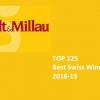Bündner Herrschaft, the rise of a noble county
By Laurent Probst - December 12, 2014
The small wine region of the Bündner Herrschaft (Graubünden) which also happens to be land of Heidi has continuously gained momentum in the past years. Wine lovers have not only discovered its wines, but also their prices which are on average higher than those produced in the Southwestern part of Switzerland. We asked ourselves if it was due to the relative proximity of the rich metropolis of Zurich, ultimately we found out that if you consider the quality, there are still pretty good bargains available in the Graubünden.
The official statistics states that the vineyards cover 423 ha with an altitude limit for vine cultivation arbitrarily set at 600m. Two geographical landmarks define the vineyard, the Rhine to the West and the Chur district to the South. The area stretches for 20 km between Chur and Bad Ragaz; at the southern tip you find the small town of Landquart a transportation hub that makes it easy to reach.

Among the four towns of the Bündner Herrschaft, Malans is probably the oldest. The cohesion of the old town is remarkable. The very nature of some patrician mansions demonstrates the wealth of families, which have been established here since a long time. But this also applies to other wine-growing municipalities such as Maienfeld and Fläsch which received the Wakker Prize in 2010 (a Swiss Heritage award). An important element for people interested to undertake a wine-tour in the region.
Among the grapes available in the region, let's talk first about the rare but very interesting indigenous grape: the Completer, who was already mentioned in 1321! It produces wines of great vivacity, designed to age well, some winemakers produce a modern wine dry and rich, others produce a more traditional local yellow wine. The success of the grape lies more in the hands and the styles of those who produce it. Both can turn out to be amazing.
If the genetic origins of the Completer remain unclear, it almost certainly developed on the eastern slope of the alluvial hill on which the town of Malans and its entire vineyard lie. For Martin Donatsch, this place is the natural choice to grow Completer because the cold winds, which normally blow down the Rhine valley, push the warmer winds towards the vineyard Malans; a phenomenon made possible due to the elbow-shape of the valley in that area. The warm winds act like a thermal enhancer highly useful for this late variety.
Among the other varieties tasted and frequently present in those vineyards, one finds Sauvignon Blanc (9 ha), the Pinot Gris (10 ha), the Pinot Blanc (11 ha), the Chardonnay (15 ha) and the Müller-Thurgau which demonstrate at the quality of the Graubünden terroirs and the talent of the winemakers.
Now let's talk about the main grape variety in terms of planted surfaces: the Pinot Noir (320 ha). This Burgundy grape variety was planted in the Graubünden in 1630, by farmers who served as mercenaries in the armies of the French king.
The influence of Burgundy can be felt throughout the area, many winemakers present their wines in a manner similar though unofficial of Burgundy: This wine is my "Village", the latter a "Premier Cru" and the former a "Grand Cru".
If the Pinot Noir has become emblematic of the Graubünden vineyards it is because they now compete among the major producers and have become recognized by experts, thanks to both a great terroir and talented men who interpret them.



